
Tourist Information, Vendee History, Accommodation, Photos, Reviews, Maps,
Custom Search
Web |


|
| contact us | ||
| Advertise |
|
| month by month guide | ||
| Entertainment |
| January | ||
| February | ||
| March | ||
| April | ||
| May | ||
| June | ||
| July | ||
| August | ||
| September | ||
| October | ||
| November | ||
| December |
| Car Boot Sale | ||
| Discos |
|
| Getting About | ||
| Public Holidays, | ||
| Getting to the Vendee | ||
| Bike Hire | ||
| Photos | ||
| Weather | ||
| Vendee Wars | ||
| Videos | ||
| Maps & Books | ||
| Vendee Wines | ||
| Vendee Information |
|
| Vendee Restaurants | ||
| Coastal Region | ||
| Haut Bocage | ||
| Bas Bocage | ||
| Plaine | ||
| Sud Vendee | ||
| Marais Poitevin | ||
| Marais Breton | ||
| Marais Olonne |
|
| All Activities | ||
| fishing | ||
| sailing | ||
| golf | ||
| Walking | ||
| Cycling | ||
| Surfing | ||
| Karting | ||
| Swimming | ||
| Canoeing | ||
| Paintball | ||
| Horse Riding | ||
| Adventure Parks | ||
| Arts & Crafts |
|
| All Attractions | ||
| Theme Parks | ||
| Towns and Villages | ||
| Chateaux and Churches | ||
| beaches of the vendee | ||
| Adventure Parks | ||
| Amusement Parks | ||
| Water Parks | ||
| Childrens Attractions | ||
| Markets | ||
| Zoos & Gardens | ||
| Museums | ||
| Rivers of the Vendee | ||
| Vendee Islands | ||
| Vendee Wars Sites | ||
| Mills of the Vendee |
| inland beaches |
|
| Gites | ||
| Hotels | ||
| Camping | ||
| Bed & Breakfast |
| Gites with Pools | ||
| Gites Complex | ||
| All Gites |
| Camping Coastal Region | ||
| Camping Haut Bocage | ||
| Camping Marais Poitevin | ||
| Camping Sud Vendee |
|
| Coastal Region | ||
| Bas Bocage | ||
| Haut Bocage | ||
| Plaine | ||
| Sud Vendee | ||
| Marais Poitevin | ||
| Marais Breton | ||
| Marais Olonne | ||
| Mervent Forest |
Ile d'Yeu
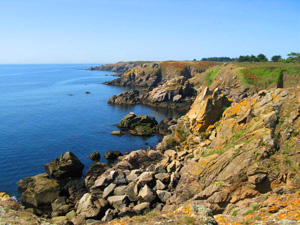
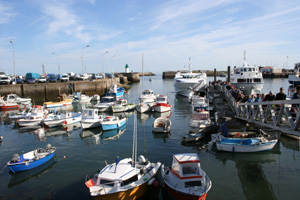
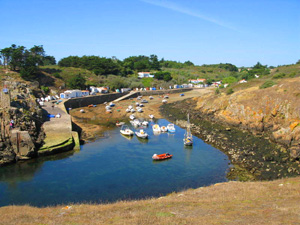
The
Ile D'Yeu or the island of Yeu lies 10 kilomeres off St. Jean de Mont on
the North Vendéen coast. Even though it is a small island it has all of
the landscape features of the Vendée. The east coast of the island has
sandy beaches and dunes backed by pine forests, a feature typical of the
mainland coast. Along the west coast sandy coves are dotted amongst low
granite cliffs, which bear a striking resemblance to those on either
side of Les Sables D'Olonne and those on the north and east coasts of
the Ile de Noirmoutier. Incredibly even though it is such a small island
it still has areas of marais and bocage.
By far the most popular method of getting to the island is by ferry, although it is possible to reach it by helicopter from La Barre de Mont. The ferries leave from Fromentine all year round, but in the summer months they also leave from La Fosse on the Ile de Noirmoutier, and St.Gilles-Croix-de-Vie. The ferry journey takes about 45 minutes arriving in Port-Joinville, a colourful fishing harbour and the main town on the island. Port-Joinville buzzes with activity, fishing boats and pleasure craft are constantly entering and leaving the harbour and there is a regular stream of tourists disembarking from the ferries. The many shops, bars, cafes and restaurants that line the harbour side are a hive of tourist activity which all adds to the balance and vibrancy of this charming working town.
Depending mainly on the length of your stay, there are a variety of ways that one can use to see the sights of the island. There are several bus trips designed for the day tripper which will take one around many of the attractions and give one a taste of the island. For the more independent traveller there are cars for hire, allowing one more freedom, but as with the bus there are many places that one will not be able to access. The ideal way to get the most out of the island is by hiring a bike, which are readily available. The Ile d'Yeu is only 10 kilometres long and 4 kilometres wide but with a 46 kilometre coastline one will not be able to dawdle if one is determined to see it all in a day. There are 3 well marked cycle routes the longest being 30 kilometres which will probably take 5 hours 30 minutes. One may however just wish to take in the atmosphere of Port-Joinville, perhaps to eat a leisurely meal in one of the restaurants along the harbour front, do a bit of shopping in the quayside shops, or have a stroll around the backstreets of this quaint little town. If however one is staying on the island for longer in one of the many hotels, B&B's, Gites or camp sites, one can unravel the island’s charm at a much more leisurely pace.
Eating out on the Island can be a bit of a disappointment, apart from the restaurants in Port-Joinville there is only one other restaurant on the island, in Port de la Meule and even that great French tradition of the bar/cafe is a rarity on the island. If one is lucky one may find a mobile ice-cream/drinks wagon on some of the beaches, but best advice is to take one’s own refreshments.
The other disappointment regarding restaurants on the island is the quality of the food that they serve. We had been warned by my French neighbour that the restaurants on the island were unsympathetic, but it wasn’t until we tried to eat that we began to understand what he meant. It would not be unreasonable to expect that an island that claims fishing and tourism as its main industries would have excellent fish restaurants serving fresh local produce. The reality is that most of the restaurants that we tried had a poor selection, especially of fish, on offer and what little there was in the main was of mediocre quality and served without fresh vegetables. The exception was the locally grown mussels which could be found in most restaurants, were served in several different ways and were delicious.
The island has had a human presence since the Neolithic period, and bearing witness to this are the many Menhirs(standing stones) and Dolmens (burial chambers) which can be found all over the island. The Romans however do not seem to have had much of an interest in the island as little evidence has been found of their presence.
Religion played a central role in the development of the island during the medieval period. St. Martin and St. Hilaire came to the island in the 9th century to preach evangelism and they were followed by the monks from the Abbey of Bangor in Ireland who constructed a monastery dedicated to St. Hilaire.
In the 10th century St. Sauveur, the then capital of the island saw the construction of its church.
Fortification of the island took place in the 16th century to guard against a perceived seaward threat and to control smuggling which was prolific at that time. The threat never materialized which meant that the defences were never tested. Of this fortification only the Vieux Château build on a rocky outcrop, which becomes an island at high tide, remains today.
The sea has always played a vital role in the prosperity of the island, but for two very different reasons. Firstly, the island was the departure place for many religious missionaries to Africa, The Americas and other places in the New World. This was evidenced in the fact that for a long time the island was called "Ilsle Dieu" or God's island. The second reason was of course fishing. Port-Joinville was the first and largest Cod port of France and the fishing vessels voyaged across the Atlantic in search of their catch. Around the beginning of the 20th century the port became more important for tuna fishing, a trade that still exists to this day. The fishing industry now consists of deep sea fishing for cod, tuna and other pelagic species, and local inshore fishing for tuna, crabs, lobsters and last but by no means least mussel farming.
The picture postcard cottages, small harbours and men of character make this an interesting island and wherever there are beautiful landscapes and colourful people artists are never far away. The Ile d'Yeu is no exception, there seem to be a large number of art galleries on the island, along with art exhibitions of every description. Whether one is an artist or not, the appreciation of the beautiful natural landscapes, the history, and the colourful characters will all make a lasting impression for one to take away and cherish.
Port de la Meule pretty picture postcard fishing village.
Vieux Château. Ruins of the medieval fortress
Return to find more Attractions of the Vendée
By far the most popular method of getting to the island is by ferry, although it is possible to reach it by helicopter from La Barre de Mont. The ferries leave from Fromentine all year round, but in the summer months they also leave from La Fosse on the Ile de Noirmoutier, and St.Gilles-Croix-de-Vie. The ferry journey takes about 45 minutes arriving in Port-Joinville, a colourful fishing harbour and the main town on the island. Port-Joinville buzzes with activity, fishing boats and pleasure craft are constantly entering and leaving the harbour and there is a regular stream of tourists disembarking from the ferries. The many shops, bars, cafes and restaurants that line the harbour side are a hive of tourist activity which all adds to the balance and vibrancy of this charming working town.
Depending mainly on the length of your stay, there are a variety of ways that one can use to see the sights of the island. There are several bus trips designed for the day tripper which will take one around many of the attractions and give one a taste of the island. For the more independent traveller there are cars for hire, allowing one more freedom, but as with the bus there are many places that one will not be able to access. The ideal way to get the most out of the island is by hiring a bike, which are readily available. The Ile d'Yeu is only 10 kilometres long and 4 kilometres wide but with a 46 kilometre coastline one will not be able to dawdle if one is determined to see it all in a day. There are 3 well marked cycle routes the longest being 30 kilometres which will probably take 5 hours 30 minutes. One may however just wish to take in the atmosphere of Port-Joinville, perhaps to eat a leisurely meal in one of the restaurants along the harbour front, do a bit of shopping in the quayside shops, or have a stroll around the backstreets of this quaint little town. If however one is staying on the island for longer in one of the many hotels, B&B's, Gites or camp sites, one can unravel the island’s charm at a much more leisurely pace.
Eating out on the Island can be a bit of a disappointment, apart from the restaurants in Port-Joinville there is only one other restaurant on the island, in Port de la Meule and even that great French tradition of the bar/cafe is a rarity on the island. If one is lucky one may find a mobile ice-cream/drinks wagon on some of the beaches, but best advice is to take one’s own refreshments.
The other disappointment regarding restaurants on the island is the quality of the food that they serve. We had been warned by my French neighbour that the restaurants on the island were unsympathetic, but it wasn’t until we tried to eat that we began to understand what he meant. It would not be unreasonable to expect that an island that claims fishing and tourism as its main industries would have excellent fish restaurants serving fresh local produce. The reality is that most of the restaurants that we tried had a poor selection, especially of fish, on offer and what little there was in the main was of mediocre quality and served without fresh vegetables. The exception was the locally grown mussels which could be found in most restaurants, were served in several different ways and were delicious.
The island has had a human presence since the Neolithic period, and bearing witness to this are the many Menhirs(standing stones) and Dolmens (burial chambers) which can be found all over the island. The Romans however do not seem to have had much of an interest in the island as little evidence has been found of their presence.
Religion played a central role in the development of the island during the medieval period. St. Martin and St. Hilaire came to the island in the 9th century to preach evangelism and they were followed by the monks from the Abbey of Bangor in Ireland who constructed a monastery dedicated to St. Hilaire.
In the 10th century St. Sauveur, the then capital of the island saw the construction of its church.
Fortification of the island took place in the 16th century to guard against a perceived seaward threat and to control smuggling which was prolific at that time. The threat never materialized which meant that the defences were never tested. Of this fortification only the Vieux Château build on a rocky outcrop, which becomes an island at high tide, remains today.
The sea has always played a vital role in the prosperity of the island, but for two very different reasons. Firstly, the island was the departure place for many religious missionaries to Africa, The Americas and other places in the New World. This was evidenced in the fact that for a long time the island was called "Ilsle Dieu" or God's island. The second reason was of course fishing. Port-Joinville was the first and largest Cod port of France and the fishing vessels voyaged across the Atlantic in search of their catch. Around the beginning of the 20th century the port became more important for tuna fishing, a trade that still exists to this day. The fishing industry now consists of deep sea fishing for cod, tuna and other pelagic species, and local inshore fishing for tuna, crabs, lobsters and last but by no means least mussel farming.
The picture postcard cottages, small harbours and men of character make this an interesting island and wherever there are beautiful landscapes and colourful people artists are never far away. The Ile d'Yeu is no exception, there seem to be a large number of art galleries on the island, along with art exhibitions of every description. Whether one is an artist or not, the appreciation of the beautiful natural landscapes, the history, and the colourful characters will all make a lasting impression for one to take away and cherish.
Port de la Meule pretty picture postcard fishing village.
Vieux Château. Ruins of the medieval fortress
Return to find more Attractions of the Vendée
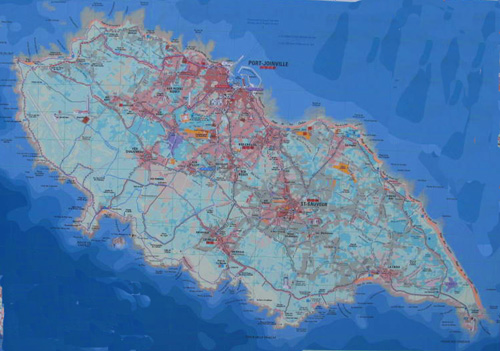
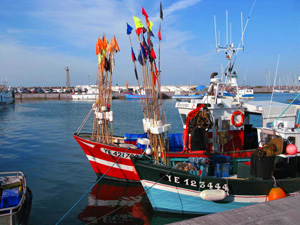
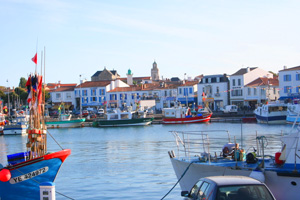
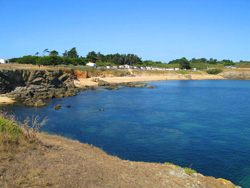
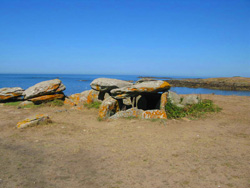
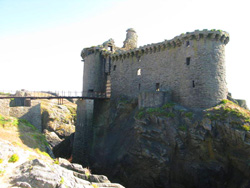
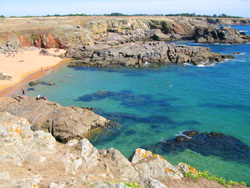
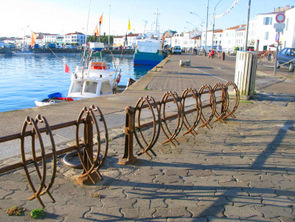
In
accordance with the law "and Freedoms" of January 6, 1978, you have the
right to access and rectify information concerning you. If you wish to
exercise this right, please contact us.
© Copyright Vendee-Guide.co.uk 2009-12 This Website is built with Bluevoda from Vodahost
© Copyright Vendee-Guide.co.uk 2009-12 This Website is built with Bluevoda from Vodahost





